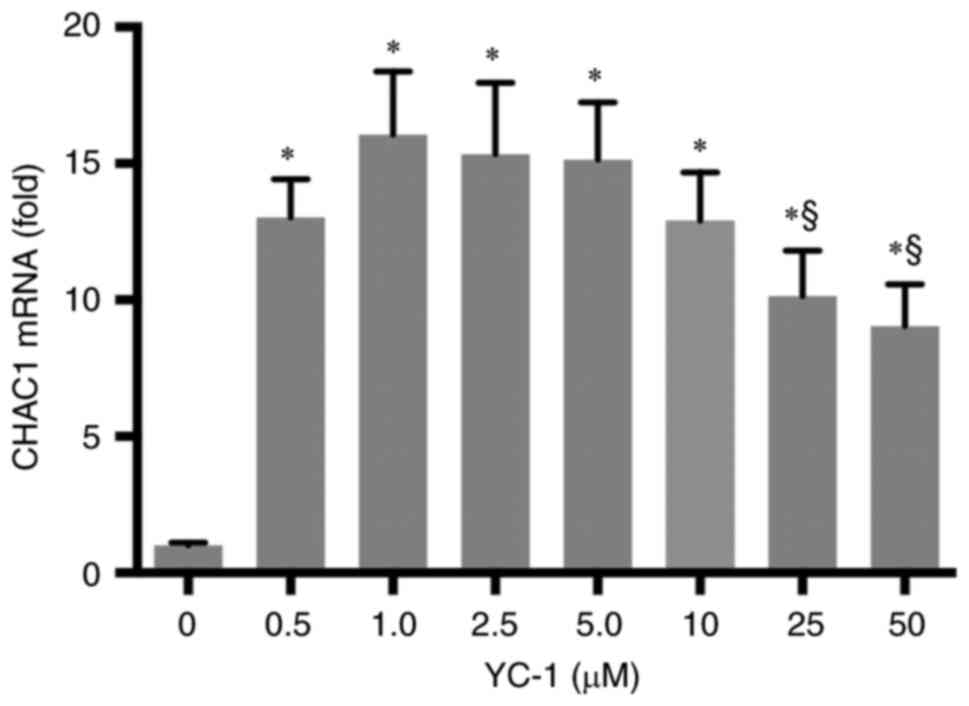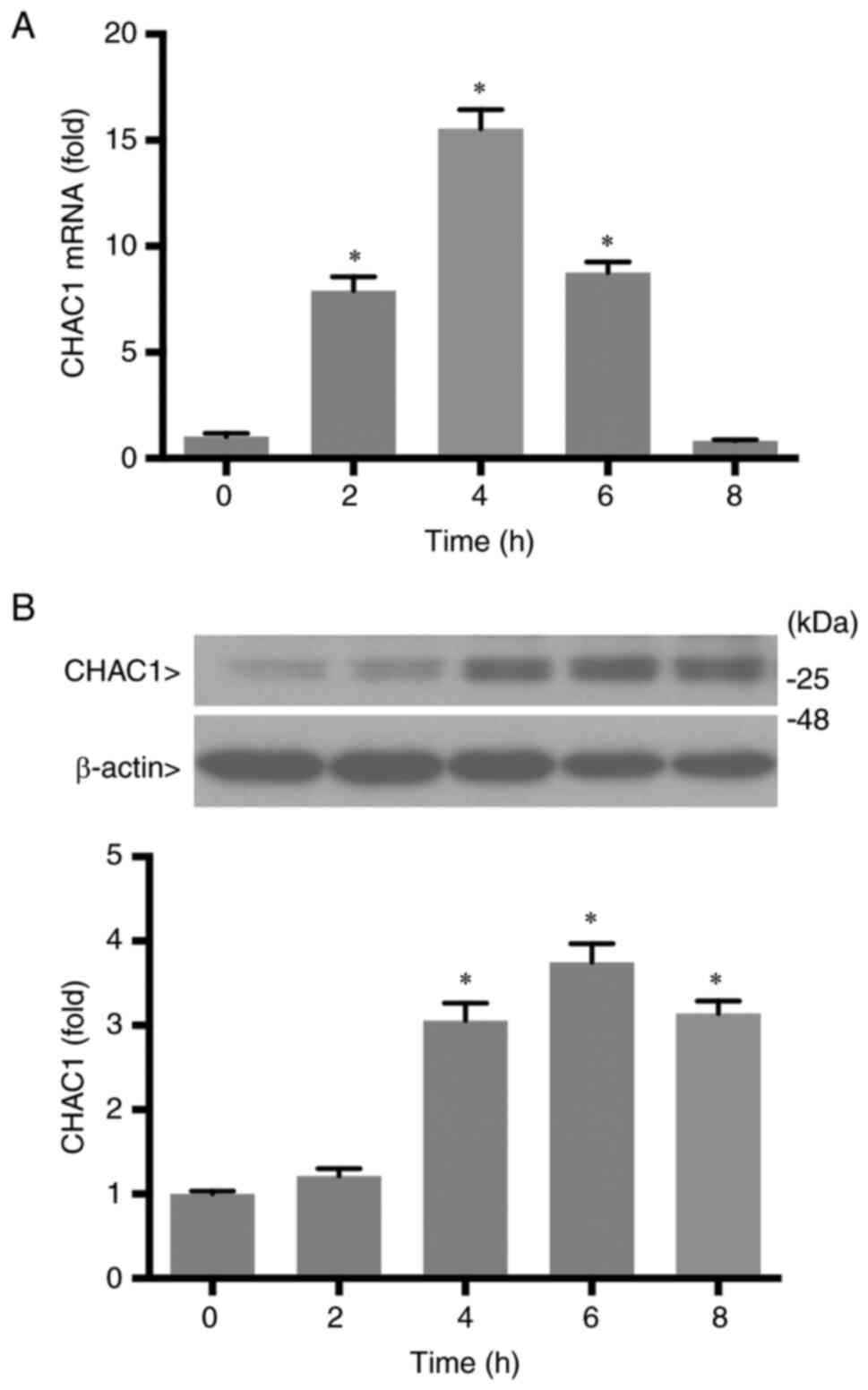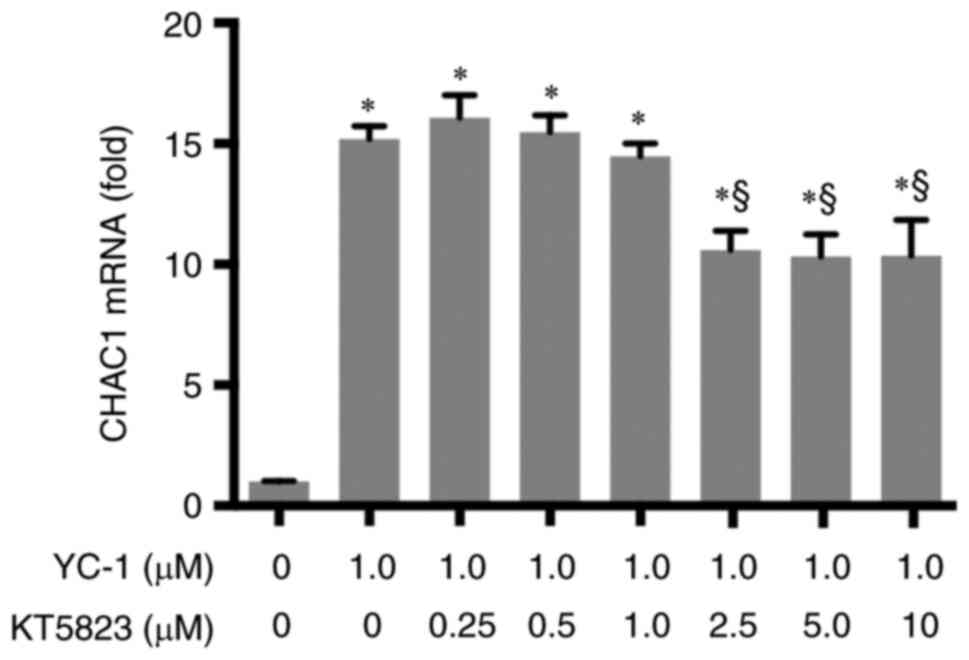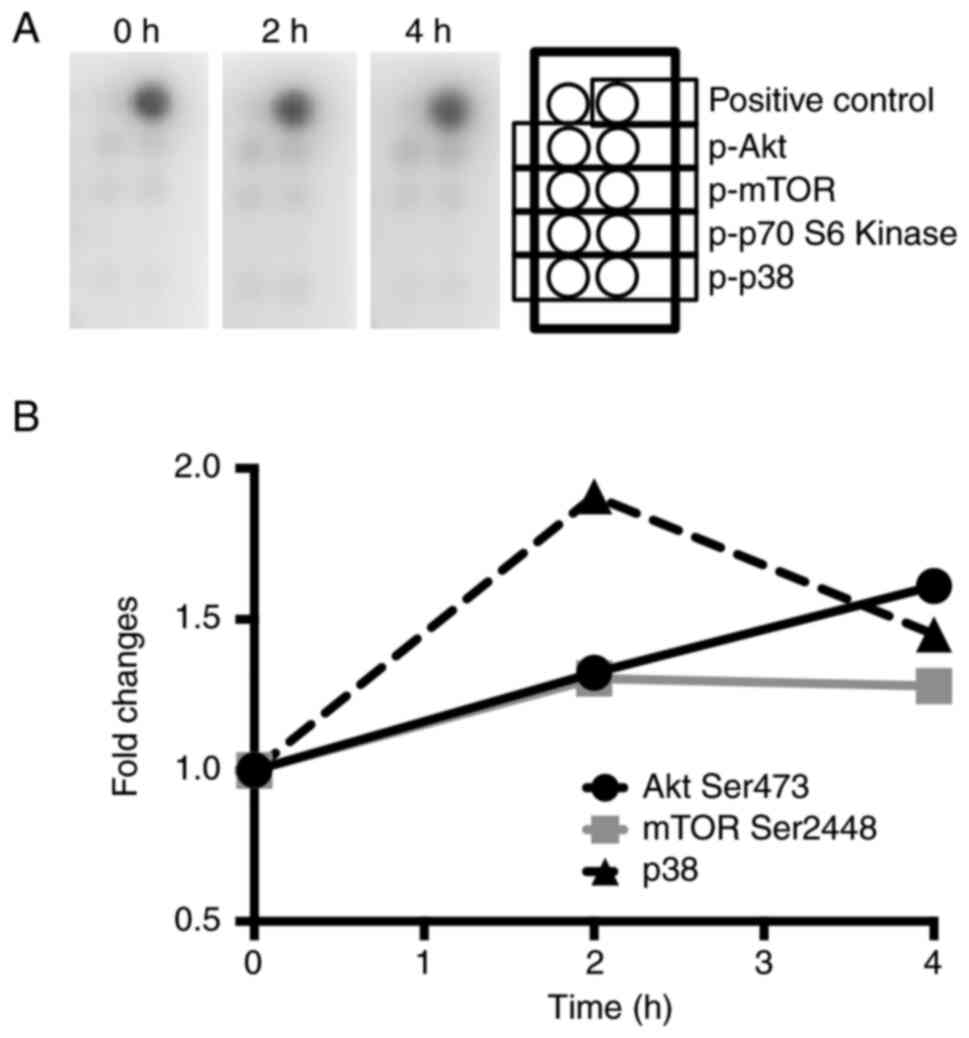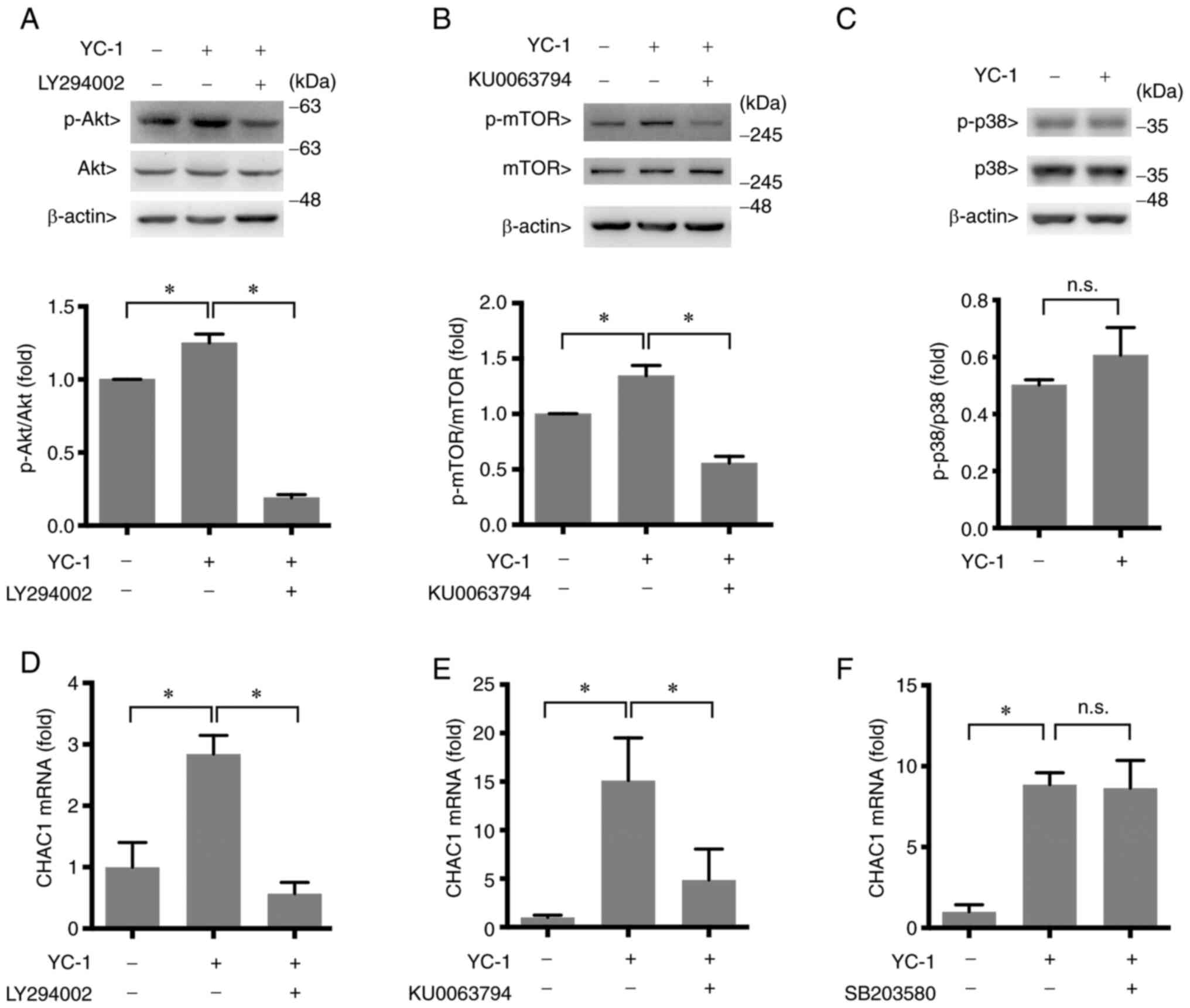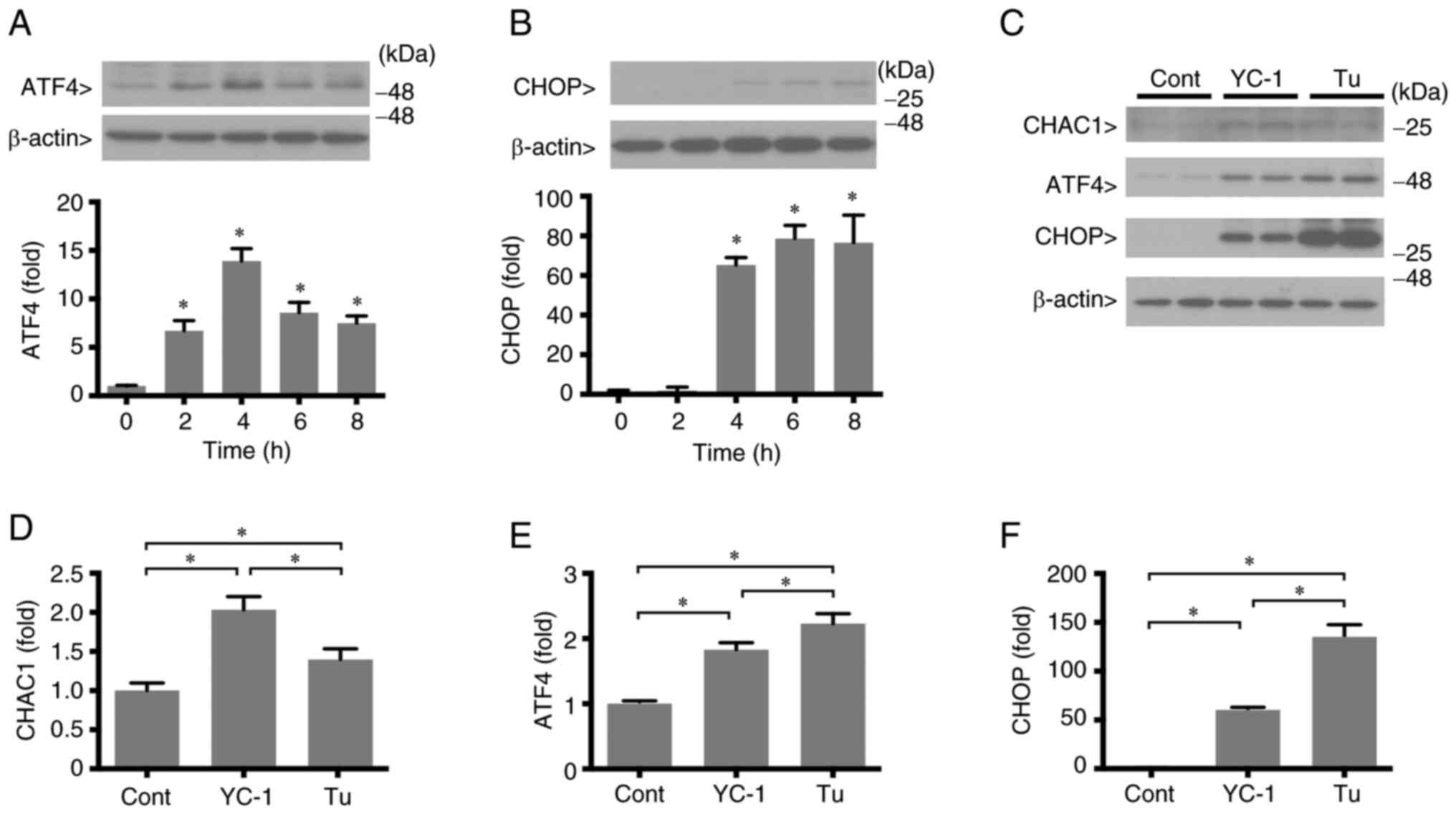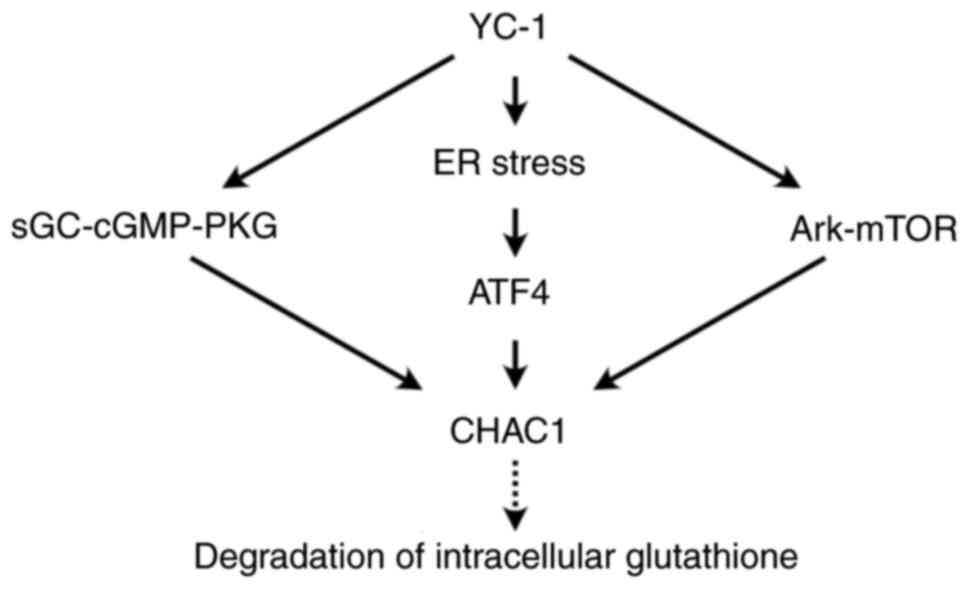Signaling pathways upregulating glutathione‑specific γ‑glutamylcyclotransferase 1 by 3‑(5'‑hydroxymethyl‑2'‑furyl)‑1‑benzylindazole
- Authors:
- Published online on: September 26, 2023 https://doi.org/10.3892/mmr.2023.13103
- Article Number: 216
Abstract
Introduction
The endoplasmic reticulum (ER) plays an important role in the folding and maturation of newly produced secretory and membrane proteins (1). Although the ER controls the quality of newly generated proteins, pathological conditions such as renal disease, diabetes and atherosclerosis result in the accumulation of misfolded and unfolded proteins in the ER (2). This leads to a condition called ER stress, and the protective response to ER stress is called the unfolded protein response (UPR). The UPR has three branches: Protein kinase R (PKR)-like ER kinase (PERK), inositol-requiring enzyme 1 and activating transcription factor (ATF) 6 (3). In response to ER stress, the UPR upregulates ER chaperones to restore normal cell function (4). However, when ER stress is excessive and/or prolonged, the UPR initiates apoptotic processes (5–7). One of the key factors responsible for apoptotic induction downstream of ER stress is the CCAAT/enhancer binding protein (C/EBP) homologous protein (CHOP). CHOP is upregulated by ATF4, a transcription factor that responds to ER stress (8).
Glutathione-specific γ-glutamylcyclotransferase 1 (CHAC1) was identified as a UPR-induced gene (9). CHAC1 is a pro-apoptotic factor downstream of ER stress (9,10). In addition to its pro-apoptotic function, CHAC1 degrades intracellular glutathione, contributing to redox homeostasis in the cell (10,11). Because CHAC1-mediated degradation of glutathione enhances necroptosis and ferroptosis, which are previously identified mechanisms of cell death (12), it is considered that CHAC1 has important roles in cell death. CHAC1 transcription is regulated by ATF4, ATF3 and C/EBPβ, which are transcription factors responsive to ER stress (9,11,13). Thus, CHAC1 is regulated by several transcription factors. However, the signaling pathways that regulate CHAC1 expression remain unclear.
Renal ischemia-reperfusion injury (IRI) induces a remarkable reduction in glutathione levels in the kidney (14). In addition, IRI induces ER stress in the kidney (15). These results indicated that CHAC1 is expressed in renal tubular cells. In the present study, CHAC1 regulation was investigated in tubular cells. It was observed that 3-(5′-hydroxymethyl-2′-furyl)-1-benzylindazole (YC-1), an activator of soluble guanylyl cyclase (sGC) (16), increases CHAC1 expression in cultured human kidney tubular cells (HK-2). Therefore, in the present study, the signaling pathways that contribute to CHAC1 induction by YC-1 in HK-2 cells were investigated. The results revealed that the increase in CHAC1 expression by YC-1 occurred via the cGMP-dependent protein kinase (PKG), ER stress and AKT-mTOR pathways. It was also observed that CHAC1 upregulation decreased intracellular glutathione concentration in HK-2 cells. These findings indicated that CHAC1 is regulated by various signaling pathways and is involved in cellular redox homeostasis.
Materials and methods
Antibodies, reagents and kits
Anti-CHAC1 antibody (1:1,000; cat. no. AV42623) was purchased from Sigma-Aldrich; Merck KGaA. Anti-ATF4 was obtained from Santa Cruz Biotechnology, Inc (1:1,000; cat. no. sc200). Anti-CHOP (1:1,000; cat. no. 2895) and anti-β-actin (1:5,000: cat. no. 4970) antibodies were purchased from Cell Signaling Technology, Inc. The YC-1 (cat. no. 82560) and KT5823 (cat. no. 10010965) were obtained from Cayman Chemical Company. Tunicamycin (cat. no. 202-08241) was obtained from Fujifilm Wako Chemicals. LY294002 (cat. no. 440202), KU0063794 (cat. no. SML0382) and SB203580 (cat. no. S8307) were purchased from Sigma-Aldrich; Merck KGaA. BCA protein assay kit (cat. no. T9300A) was purchased from Takara Bio, Inc. The DetectX glutathione fluorescence detection kit (cat. no. K006-F1) was purchased from Arbor Assays. The PathScan intracellular signaling array kit (cat. no. 7323) was purchased from Cell Signaling Technology, Inc.
Cell culture and chemical treatment
HK-2 cell, which is a human kidney tubular cell was purchased from the American Type Culture Collection (cat. no. CRL-2190). HK-2 cells were cultured at 37°C in a humidified atmosphere with 5% CO2 until 80% confluency in DMEM (Nissui Corporation) containing 10% fetal bovine serum (Serana Europe GmbH), 100 units/ml penicillin and 100 µg/ml streptomycin. For the chemical treatment of HK-2 cells, the cells were cultured in serum-free DMEM for 24 h and then treated with YC-1 or tunicamycin. When the chemical compounds, including 50 µM LY294002, 10 µM KU0063794 and 10 µM SB203580, were used, the compounds were added just before YC-1 treatment and were incubated for 4 h at 37°C. The concentrations of LY294002, KU0063794 and SB20358 were referred to previous studies (17–19). Almost all cells after 24-h incubation in serum-free medium attached on the bottom of the culture plate, indicating that the incubation did not induce apoptosis.
Western blotting
Cells were lysed in lysis buffer [20 mM Tris-HCl (pH 8.0), 0.15 M NaCl, 10 mM EDTA, 1% Triton X-100, 1 mM phenylmethylsulfonyl fluoride, protease inhibitor mix (GE Healthcare)]. The protein concentration in the lysates was measured using a BCA protein assay kit. The proteins (25 µg/lane) were separated on 7.5 or 15% SDS polyacrylamide gels and transferred onto polyvinylidene fluoride membranes. The membranes were blocked with TS solution [150 mM NaCl, 20 mM Tris-HCl (pH 8.0)] containing 1% non-fat dry milk for 30 min at room temperature, and then incubated with a primary antibody overnight at 4°C and probed with an HRP-conjugated secondary antibody (KPL, Inc.) for 1 h at room temperature. Immunoreactive bands were detected using ImmunoStar LD (FUJIFILM Wako Pure Chemical Corporation) and visualized using a WSE-6200H LuminoGraph II (ATTO Corporation). The proteins were quantified by conducting densitometric analysis using ImageJ software 1.41o (National Institutes of Health).
Reverse transcription-quantitative PCR (RT-qPCR)
Total RNA was isolated from the HK-2 cells using ISOGEN (Nippon Gene Co., Ltd.). Total RNA was subjected to qPCR using the PrimeScript RT reagent Kit with Oligo dT Primer (cat. no. RR047A; Takara Bio, Inc) and THUNDERBIRD SYBR qPCR Mix (cat. no. QPS-201; Toyobo). The reverse transcription was performed according to the manufacturer's instructions; cDNA was synthesized by incubation at 37°C for 15 min. The following primers were used for the analyses of CHAC1 mRNA levels: CHAC1 forward, 5′-GTGGTGACGCTCCTTGAAGA-3′ and reverse, 5′-TTCAGGGCCTTGCTTACCTG-3′; and 36B4 forward, 5′-TCGACAATGGCAGCATCAC-3′ and reverse, 5′-TGATGCAACAGTTGGGTAGC-3′. 36B4 was used for the internal control. The thermocycling conditions consisted of a denaturation at 95°C for 20 sec, followed by 45 cycles of denaturation at 95°C for 15 sec, annealing at 60°C for 15 sec and extension at 72°C for 20 sec. CHAC1 expression levels were calculated with the 2−ΔΔCq method (20).
Analysis of signaling pathways
To investigate the signaling pathway in HK-2 cells treated with YC-1, a PathScan intracellular signaling array kit (cat. no. 7323; Cell Signaling Technology, Inc) was used according to the manufacturer's instructions. HK-2 cells were incubated at 37°C in serum-free DMEM medium for 24 h. Subsequently, cells were treated with 1 µM YC-1 at 37°C for 2 and 4 h. After washing the cells with ice cold PBS, HK-2 cells were lysed in lysis buffer supplemented with 1 mM phenylmethylsulfonyl fluoride and protease inhibitor mix. The lysates were diluted to 1.0 mg/ml in Array Diluent Buffer. A total of 70 µl of the lysate were added to each well of the Array Slide and incubated overnight at 4°C. Chemiluminescence was detected using a chemiluminescent film (GE Healthcare). Chemiluminescence intensity was measured using ImageJ analysis software.
Analysis of the intracellular concentration of glutathione
A glutathione fluorescence detection kit (K006-F1; Arbor Assays) was used according to the manufacturer's instructions. Briefly, HK-2 cells reaching 70% confluency were washed with PBS and lysed with a 5% 5-sulfo-salicylic acid solution. After incubating the lysed cells at 4°C for 10 min, they were centrifuged at 20,600 × g for 10 min at 4°C. The prepared lysates were diluted 1:5 in an assay buffer and fluorescence intensities were measured using a Varioskan Flash spectral scanning multimode reader (Thermo Fisher Scientific, Inc.). Small interfering (si)CHAC1 (cat. no. sc-90164) and control siRNAs (cat. no. sc-37007) were obtained from Santa Cruz Biotechnology, Inc. The sequences of CHAC1 siRNA and control siRNA are not open in the manufacturer's instraction. After changing culture medium to DMEM without serum, siRNAs (12.5 nM final concentration) were simultaneously transfected using Lipofectamine RNAiMAX (Thermo Fisher Scientific, Inc.) and incubated at 37°C for 24 h.
Statistical analysis
Data are presented as the mean ± standard error of the mean. GraphPad Prism 6.0d (Graphpad Software: Dotmatics) was used for statistical analysis. Statistical significance was assessed using unpaired Student's t-test or one-way ANOVA followed by Tukey's post hoc test, where values of P<0.05 were considered to indicate a statistically significant difference.
Results
CHAC1 is induced by YC-1
YC-1 treatment upregulated CHAC1 expression in the human kidney tubular cell line HK-2. First, the upregulation of CHAC1 expression by YC-1 was confirmed. YC-1 treatment reproducibly increases CHAC1 expression levels in HK-2. The expression level of CHAC1 was the highest when treated with 1 µM YC-1. The CHAC1 expression decreased above 25 µM concentration (Fig. 1). Therefore, 1 µM YC-1 was used for subsequent experiments.
Next, the time-dependent upregulation of CHAC1 upon treatment with 1 µM YC-1 was investigated. CHAC1 mRNA levels reached a maximum at 4 h after YC-1 treatment and then gradually decreased (Fig. 2A). The protein levels of CHAC1 became detectable 2 h after those of mRNA were detected, and the maximum level was observed at 6 h (Fig. 2B). Thus, YC-1 increased CHAC1 expression in a concentration- and time-dependent manner.
CHAC1 induced by YC-1 is partially inhibited by treatment with a PKG inhibitor
Because YC-1 is an sGC activator, it has been suggested that CHAC1 is induced through the sGC-cGMP-PKG signaling pathway. Therefore, the effect of KT5823, a PKG inhibitor, on CHAC1 induction by YC-1 was studied. HK-2 cells were treated with varying concentrations of KT5823. As demonstrated in Fig. 3, KT5823 significantly decreased CHAC1 expression levels at a concentration of 2.5 µM. CHAC1 expression reduced to ~40% of its maximum level. Higher KT5823 concentrations did not result in a further decrease in CHAC1. These results revealed that YC-1 partially induced CHAC1 expression via the sGC-cGMP-PKG pathway. In addition, other signaling pathways contributed to the induction of CHAC1 by YC-1.
YC-1 upregulates CHAC1 through the AKT-mTOR pathway
It is possible that YC-1 increases CHAC1 expression through several signaling pathways. The involvement of other signaling pathways in the regulation of CHAC1 expression by YC-1 was studied. An antibody array kit that detects signaling factors was used to observe the signaling pathways activated by YC-1. The phosphorylation levels of Akt, mTOR and p38 increased following YC-1 treatment, whereas phosphorylated (p-)p70 S6 kinase was almost undetectable (Fig. 4A and B). Therefore, Akt, mTOR and p38 may participate in the induction of CHAC1 expression by YC-1. However, the result was observed in the analysis using just one sample. Therefore, to confirm significance of the upregulated phosphorylation of Akt, mTOR and p38, western blot analysis was performed. The results exhibited significant increase of phosphorylation of Akt and mTOR. However, phosphorylation of p38 was not significantly increased. These results indicated that CHAC1 was induced via the Akt-mTOR signaling pathway (Fig. 5A-C).
To elucidate the involvement of the Akt-mTOR pathway in CHAC1 induction, the effects of inhibitors on each factor were assessed. LY294002, an inhibitor of PI-3 kinase upstream of Akt, and KU0063794, an inhibitor of mTOR, reduced the induction of CHAC1 mRNA transcription levels by YC-1 (Fig. 5D and E), indicating that the Akt-mTOR pathway participates in the upregulation of CHAC1 expression by YC-1. By contrast, SB203580, an inhibitor of p38, did not decrease CHAC1 mRNA transcription levels induced by YC-1 (Fig. 5F). These results indicated that the signaling pathway of p38 is not involved in CHAC1 induction by YC-1.
ER stress is induced by YC-1
CHAC1 is a downstream product of ER stress and ATF4 is a transcription factor that upregulates CHAC1 (11,13). Therefore, the effects of YC-1 on PERK pathway, which is one of the branches of ER stress signaling pathway and enhances ATF4, were investigated. YC-1 induced ATF4 expression; ATF4 levels significantly increased at 2 h after YC-1 treatment, reached a maximum at 4 h and then gradually decreased (Fig. 6A). In addition, YC-1 induced CHOP as well. The increase in CHOP was delayed by ATF4; it significantly increased 4 h after YC-1 treatment (Fig. 6B). These results indicated that YC-1 stimulates the PERK pathway, which is one of three branches of the ER stress. A 4 h treatment with YC-1 induced CHAC1 expression.
As a result of studying detailed mechanisms of CHAC1 regulation by the PERK signaling pathway, the effect of YC-1 was compared with that of tunicamycin, which is an inducer of ER stress (21–23). Tunicamycin induced ATF4 and CHOP expression, and this increase was significantly higher than that induced by YC-1 (Fig. 6C-F). The expression levels of CHAC1 with YC-1 are higher than those in the presence of tunicamycin. These results suggested that CHAC1 is upregulated via the ER stress pathway.
CHAC1 reduces intracellular glutathione concentration
CHAC1 is a glutathione catabolic enzyme that reduces intracellular glutathione concentration. Therefore, the intracellular glutathione concentration in HK-2 cells treated with YC-1 was measured. A total of 1 µM YC-1 reduced intracellular glutathione concentration 8 h after treatment (Fig. 7A). siCHAC1 was introduced into HK-2 cell using Lipofectamine RNAiMAX. The siRNA significantly reduced CHAC1 expression (Fig. 7B). In HK-2 cells transfected with siCHAC1, the degradation of glutathione by YC-1 was reduced (Fig. 7C). These results demonstrated that CHAC1 acts as a glutathione catabolic enzyme in tubular cells.
Discussion
Although the regulation of CHAC1 expression by several transcription factors has been previously investigated (9,10,13), the signaling pathways that regulate CHAC1 expression remain unclear. YC-1 increased CHAC1 in HK-2 cells. In the present study, the signaling pathways involved in CHAC1 induction by YC-1 in cultured human tubular HK-2 cells were investigated.
YC-1 is an sGC activator (16); therefore, it is possible that YC-1 increases CHAC1 expression via the sGC-cGMP-PKG pathway. The results of the present study revealed the involvement of the sGC-cGMP-PKG pathway in the induction of CHAC1 by YC-1. cGMP is produced downstream of the nitric oxide (NO) signaling pathway. IRI induces inducible NO synthase (iNOS), which produces NO in the kidney (24–26), indicating that CHAC1 is induced through the NO signaling pathway. However, the effect of the PKG inhibitor was only partial. Therefore, the involvement of other signaling pathways in CHAC1 induction by YC-1 was predicted. Signaling pathway analysis using an antibody array demonstrated that YC-1 activated p38, AKT and mTOR. Among the signaling pathways induced by YC-1, the AKT-mTOR pathway participates in the upregulation of CHAC1. Although the phosphorylation of p38 appeared to be increased on antibody array, western blot analysis did not reveal significant increase of phosphorylation of p38 and the inhibitor SB203580 did not inhibit the upregulation of CHAC1. The signal intensities of p-p38 on antibody array were weak. Therefore, it is suggested that the effect of YC-1 on p38 phosphorylation is slight. In the present study, the phosphorylation of p70 S6 kinase was hardly detectable, although it was downstream of the AKT-mTOR pathway. These results indicated that CHAC1 was induced through the AKT-mTOR signaling pathway via downstream signals other than p70 S6 kinase. In addition, YC-1 induced the PERK pathway which is one of the branches of the three ER stress pathways, indicating that the PERK pathway contributes to the upregulation of CHAC1 expression. Because it is known that CHAC1 is regulated by ATF4 (11,13), PERK pathway-induced ATF4 expression may upregulate CHAC1. Tunicamycin, which is a strong inducer of ER stress, was used to clear detailed regulation mechanisms of CHAC1 and compare the effects of tunicamycin on PERK pathway with that of YC-1. A comparison of YC-1 with tunicamycin revealed that tunicamycin induces ATF4 and CHOP more highly than YC-1, indicating that the induction of the PERK pathway by YC-1 is not as strong as that of tunicamycin. However, YC-1 induced CHAC1 expression to a greater extent than tunicamycin. These findings support the hypothesis that CHAC1 is involved in several signaling pathways in addition to the PERK pathway. CHOP, a gene downstream of ER stress, is known to induce apoptosis and is regulated by ATF4 (27). Tunicamycin, a strong inducer of the PERK pathway, caused higher induction of CHOP than CHAC1. Meanwhile, YC-1, a weak inducer of the PERK pathway, induced CHAC1 more than CHOP. These results indicated that CHOP is mainly regulated by ER stress, whereas CHAC1 is regulated by numerous signaling pathways. Additionally, it may be involved in the inhibitory effects of CHOP on CHAC1 transcription (28).
Induction of CHAC1 by YC-1 in HK-2 cells reduced intracellular glutathione levels, indicating that CHAC1 regulates redox homeostasis. YC-1 has several effects on HK-2 cells and induces CHAC1 expression through the sGC-cGMP-PKG, AKT-mTOR and ER stress pathways (Fig. 8).
Acute kidney injury (AKI) is a common clinical problem characterized by an abrupt decrease in the glomerular filtration rate and is associated with high morbidity and mortality (29). IRI is the most common cause of AKI (30,31). CHAC1 was found to be upregulated in renal tubular cells of an IRI mouse model. Reactive oxygen species, which are generated by an abrupt supply of oxygen after reperfusion (32–34), tend to damage the ER and cause ER stress (16). NO levels are also increased via iNOS induction in IRI (24–26). Therefore, the induction of CHAC1 in tubular cells after IRI was probably due to ER stress and NO signaling.
Ferroptosis is a previously described form of programmed cell death triggered by oxidative damage (35). IRI induces ferroptosis in the kidney, and cell death is one of the causes of renal dysfunction (36). The findings of the present study demonstrated that CHAC1 degraded glutathione in HK-2 cells. In addition, it was previously revealed that knockdown of CHAC1 rescued the cysteine-starvation-induced reduction of glutathione levels and ferroptosis in human breast cancer cell lines (12). Therefore, it is possible that upregulated CHAC1 degrades glutathione and induces ferroptosis in renal IRI. In AKI, ferroptosis plays an important role in the pathogenesis and is directly related to the post-ischemic renal necrosis of renal tubules (36,37). Therefore, ferroptosis is a potential therapeutic target for IRI. The findings of the present study about regulation mechanisms of CHAC1 are informative for development of therapeutic strategies through regulation of ferroptosis in IRI.
In addition to the renal IRI, ferroptosis is a key factor that leads to IRI and organ failure, myocardial and cerebral IRI (37). Therefore, the findings of the present study that investigated the regulation pathways of CHAC1 probably contributed to elucidation of the induction mechanisms of ferroptosis and the future discovery of therapeutic targets of numerous ischemic injuries.
Acknowledgements
Not applicable.
Funding
The present study was partially supported by KAKENHI (grant no. 23K07711).
Availability of data and materials
All data generated or analyzed in the present study are included in this published article.
Authors' contributions
YK and YF contributed to the conception and design of the study, acquired and analyzed the data, and drafted the manuscript. YK and YF confirm the authenticity of all the raw data. ST and ES contributed to the study design and revision of the manuscript. All authors read and approved the final version of the manuscript.
Ethics approval and consent to participate
Not applicable.
Patient consent for publication
Not applicable.
Competing interests
The authors declare that they have no competing interests.
References
|
Anelli T and Sitia R: Protein quality control in the early secretory pathway. EMBO J. 27:315–27. 2008. View Article : Google Scholar : PubMed/NCBI | |
|
Tabas I and Ron D: Integrating the mechanisms of apoptosis induced by endoplasmic reticulum stress. Nat Cell Biol. 13:184–90. 2011. View Article : Google Scholar : PubMed/NCBI | |
|
Walter P and Ron D: The unfolded protein response: From stress pathway to homeostatic regulation. Science. 334:1081–1086. 2011. View Article : Google Scholar : PubMed/NCBI | |
|
Schröder M and Kaufman RJ: The mammalian unfolded protein response. Annu Rev Biochem. 74:739–789. 2005. View Article : Google Scholar : PubMed/NCBI | |
|
Oyadomari S, Araki E and Mori M: Endoplasmic reticulum stress-mediated apoptosis in pancreatic beta-cells. Apoptosis. 7:335–345. 2002. View Article : Google Scholar : PubMed/NCBI | |
|
Okada K, Minamino T, Tsukamoto Y, Liao Y, Tsukamoto O, Takashima S, Hirata A, Fujita M, Nagamachi Y, Nakatani T, et al: Prolonged endoplasmic reticulum stress in hypertrophic and failing heart after aortic constriction: Possible contribution of endoplasmic reticulum stress to cardiac myocyte apoptosis. Circulation. 110:705–712. 2004. View Article : Google Scholar : PubMed/NCBI | |
|
Szegezdi E, Duffy A, O'Mahoney ME, Logue SE, Mylotte LA, O'brien T and Samali A: ER stress contributes to ischemia-induced cardiomyocyte apoptosis. Biochem Biophys Res Commun. 349:1406–1411. 2006. View Article : Google Scholar : PubMed/NCBI | |
|
Fawcett TW, Martindale JL, Guyton KZ, Hai T and Holbrook NJ: Complexes containing activating transcription factor (ATF)/cAMP-responsive-element-binding protein (CREB) interact with the CCAAT/enhancer-binding protein (C/EBP)-ATF composite site to regulate Gadd153 expression during the stress response. Biochem J. 339:135–141. 1999. View Article : Google Scholar : PubMed/NCBI | |
|
Mungrue IN, Pagnon J, Kohannim O, Gargalovic PS and Lusis AJ: CHAC1/MGC4504 is a novel proapoptotic component of the unfolded protein response, downstream of the ATF4-ATF3-CHOP cascade. J Immunol. 182:466–476. 2009. View Article : Google Scholar : PubMed/NCBI | |
|
Kumar A, Tikoo S, Maity S, Sengupta S, Sengupta S, Kaur A and Bachhawat AK: Mammalian proapoptotic factor ChaC1 and its homologues function as γ-glutamyl cyclotransferases acting specifically on glutathione. EMBO Rep. 13:1095–1101. 2012. View Article : Google Scholar : PubMed/NCBI | |
|
Crawford RR, Prescott ET, Sylvester CF, Higdon AN, Shan J, Kilberg MS and Mungrue IN: Human CHAC1 protein degrades glutathione, and mRNA induction is regulated by the transcription factors ATF4 and ATF3 and a bipartite ATF/CRE regulatory element. J Biol Chem. 290:15878–15891. 2015. View Article : Google Scholar : PubMed/NCBI | |
|
Chen MS, Wang SF, Hsu CY, Yin PH, Yeh TS, Lee HC and Tseng LM: CHAC1 degradation of glutathione enhances cystine-starvation-induced necroptosis and ferroptosis in human triple negative breast cancer cells via the GCN2-eIF2α-ATF4 pathway. Oncotarget. 8:114588–114602. 2017. View Article : Google Scholar : PubMed/NCBI | |
|
Oh-Hashi K, Nomura Y, Shimada K, Koga H, Hirata Y and Kiuchi K: Transcriptional and post-translational regulation of mouse cation transport regulator homolog 1. Mol Cell Biochem. 380:97–106. 2013. View Article : Google Scholar : PubMed/NCBI | |
|
Younis NS and Ghanim AMH: The protective role of celastrol in renal ischemia-reperfusion injury by activating Nrf2/HO-1, PI3K/AKT signaling pathways, modulating NF-κb signaling pathways, and inhibiting ERK phosphorylation. Cell Biochem Biophys. 80:191–202. 2022. View Article : Google Scholar : PubMed/NCBI | |
|
Hoppins S and Nunnari J: Mitochondrial dynamics and apoptosis-the ER connection. Science. 337:1052–1054. 2012. View Article : Google Scholar : PubMed/NCBI | |
|
Martin E, Lee YC and Murad F: YC-1 activation of human soluble guanylyl cyclase has both heme-dependent and heme-independent components. Proc Natl Acad Sci USA. 98:12938–12942. 2001. View Article : Google Scholar : PubMed/NCBI | |
|
Vlahos CJ, Matter WF, Hui KY and Brown RF: A specific inhibitor of phosphatidylinositol 3-kinase, 2-(4-morpholinyl)-8-phenyl-4H-1-benzopyran-4-one (LY294002). J Biol Chem. 269:5241–5248. 1994. View Article : Google Scholar : PubMed/NCBI | |
|
García-Martínez JM, Moran J, Clarke RG, Gray A, Cosulich SC, Chresta CM and Alessi DR: Ku-0063794 is a specific inhibitor of the mammalian target of rapamycin (mTOR). Biochem J. 421:29–42. 2009. View Article : Google Scholar : PubMed/NCBI | |
|
Cuenda A, Rouse J, Doza YN, Meier R, Cohen P, Gallagher TF, Young PR and Lee JC: SB 203580 is a specific inhibitor of a MAP kinase homologue which is stimulated by cellular stresses and interleukin-1. FEBS Lett. 364:229–233. 1995. View Article : Google Scholar : PubMed/NCBI | |
|
Livak KJ and Schmittgen TD: Analysis of relative gene expression data using real-time quantitative PCR and the 2(−Delta Delta C(T)) method. Methods. 25:402–408. 2001. View Article : Google Scholar : PubMed/NCBI | |
|
Surani MA: Glycoprotein synthesis and inhibition of glycosylation by tunicamycin in preimplantation mouse embryos: Compaction and trophoblast adhesion. Cell. 18:217–227. 1979. View Article : Google Scholar : PubMed/NCBI | |
|
Yoo J, Mashalidis EH, Kuk ACY, Yamamoto K, Kaeser B, Ichikawa S and Lee SY: GlcNAc-1-P-transferase-tunicamycin complex structure reveals basis for inhibition of N-glycosylation. Nat Struct Mol Biol. 25:217–224. 2018. View Article : Google Scholar : PubMed/NCBI | |
|
Hakulinen JK, Hering J, Brändén G, Chen H, Snijder A, Ek M and Johansson P: MraY-antibiotic complex reveals details of tunicamycin mode of action. Nat Chem Biol. 13:265–267. 2017. View Article : Google Scholar : PubMed/NCBI | |
|
Liu F, Ni W, Zhang J, Wang G, Li F and Ren W: Administration of curcumin protects kidney tubules against renal ischemia-reperfusion injury (RIRI) by modulating nitric oxide (NO) signaling pathway. Cell Physiol Biochem. 44:401–411. 2017. View Article : Google Scholar : PubMed/NCBI | |
|
Walker LM, Walker PD, Imam SZ, Ali SF and Mayeux PR: Evidence for peroxynitrite formation in renal ischemia-reperfusion injury: Studies with the inducible nitric oxide synthase inhibitor L-N(6)-(1-Iminoethyl)lysine. J Pharmacol Exp Ther. 295:417–422. 2000.PubMed/NCBI | |
|
Chatterjee PK, Patel NS, Sivarajah A, Kvale EO, Dugo L, Cuzzocrea S, Brown PA, Stewart KN, Mota-Filipe H, Britti D, et al: GW274150, a potent and highly selective inhibitor of iNOS, reduces experimental renal ischemia/reperfusion injury. Kidney Int. 63:853–865. 2003. View Article : Google Scholar : PubMed/NCBI | |
|
Luo J, Xia Y, Luo J, Li J, Zhang C, Zhang H, Ma T, Yang L and Kong L: GRP78 inhibition enhances ATF4-induced cell death by the deubiquitination and stabilization of CHOP in human osteosarcoma. Cancer Lett. 410:112–123. 2017. View Article : Google Scholar : PubMed/NCBI | |
|
Nomura Y, Sylvester CF, Nguyen LO, Kandeel M, Hirata Y, Mungrue IN and Oh-Hashi K: Characterization of the 5′-flanking region of the human and mouse CHAC1 genes. Biochem Biophys Rep. 24:1008342020.PubMed/NCBI | |
|
Schiffl H, Lang SM and Fischer R: Daily hemodialysis and the outcome of acute renal failure. N Engl J Med. 346:305–310. 2002. View Article : Google Scholar : PubMed/NCBI | |
|
Edelstein CL, Ling H and Schrier RW: The nature of renal cell injury. Kidney Int. 51:1341–1351. 1997. View Article : Google Scholar : PubMed/NCBI | |
|
DuBose TD Jr, Warnock DG, Mehta RL, Bonventre JV, Hammerman MR, Molitoris BA, Paller MS, Siegel NJ, Scherbenske J and Striker GE: Acute renal failure in the 21st century: Recommendations for management and outcomes assessment. Am J Kidney Dis. 29:793–799. 1997. View Article : Google Scholar : PubMed/NCBI | |
|
Basile DP: The endothelial cell in ischemic acute kidney injury: Implications for acute and chronic function. Kidney Int. 72:151–156. 2007. View Article : Google Scholar : PubMed/NCBI | |
|
Bonventre JV and Yang L: Cellular pathophysiology of ischemic acute kidney injury. J Clin Invest. 121:4210–4221. 2011. View Article : Google Scholar : PubMed/NCBI | |
|
Kloner RA, Przyklenk K and Whittaker P: Deleterious effects of oxygen radicals in ischemia/reperfusion. Resolved and unresolved issues. Circulation. 80:1115–1127. 1989. View Article : Google Scholar : PubMed/NCBI | |
|
Cao JY and Dixon SJ: Mechanisms of ferroptosis. Cell Mol Life Sci. 73:2195–209. 2016. View Article : Google Scholar : PubMed/NCBI | |
|
Linkermann A, Skouta R, Himmerkus N, Mulay SR, Dewitz C, De Zen F, Prokai A, Zuchtriegel G, Krombach F, Welz PS, et al: Synchronized renal tubular cell death involves ferroptosis. Proc Natl Acad Sci USA. 111:16836–16841. 2014. View Article : Google Scholar : PubMed/NCBI | |
|
Li X, Ma N, Xu J, Zhang Y, Yang P, Su X, Xing Y, An N, Yang F, Zhang G, et al: Targeting ferroptosis: pathological mechanism and treatment of ischemia-reperfusion injury. Oxid Med Cell Longev. 2021:15879222021. View Article : Google Scholar : PubMed/NCBI |



